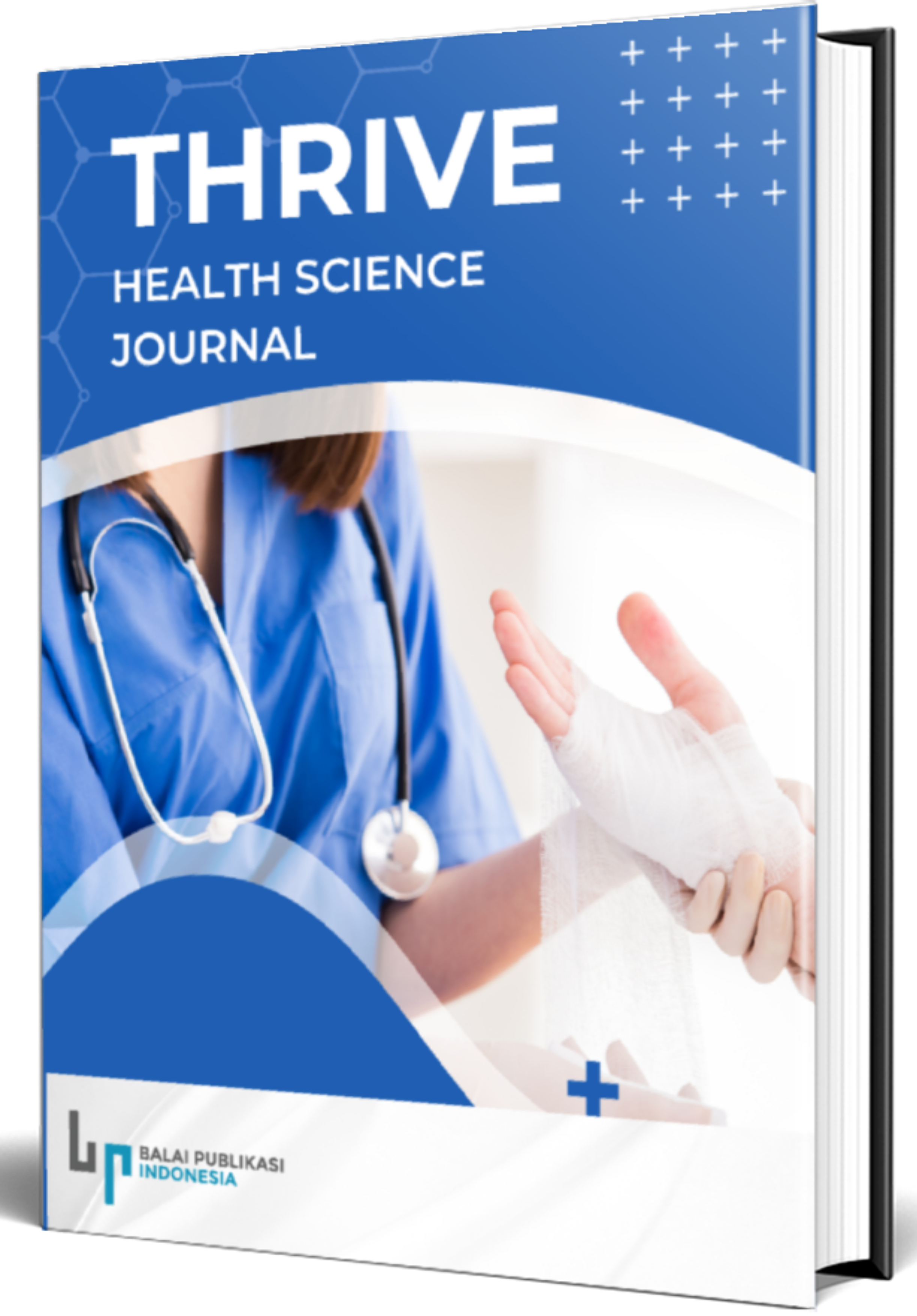Antibacterial Activity Test of Ethanol Extract of Palm Leaves (Catharantus roseus) Against Staphylococcus aureus and Escherichia coli Bacteria
Authors
Yuli Fitriana , Sri Putriani Iradhatullah , Taufan Hari Sugara , Irmatika Hendriyani , Baiq Nurbaety , Muhammad FaisalDOI:
10.56566/thrive.v2i2.424Published:
2025-09-30Issue:
Vol. 2 No. 2 (2025): SeptemberKeywords:
Antibacterial', Inhibition zone, Virgin leafArticles
Downloads
How to Cite
Abstract
Ethanol extract of virgin palm leaves (Catharantus roseus) contains active compounds that have potential as natural antibacterial. This study aims to test the antibacterial activity of the extract against Staphylococcus aureus and Escherichia coli bacteria. The leaves of the tread are extracted using the maceration method with a 70% ethanol solvent. The extraction results showed a yield of 6.1% and the identification of compound content showed the presence of alkaloids, flavonoids, saponins, tannins, and phenols. The antibacterial test was carried out by disc diffusion method using concentrations of 60%, 80%, and 100%. Antibacterial activity was tested by calculating the resulting inhibition zones against both types of bacteria. The results showed that in Staphylococcus aureus bacteria, the concentration of 100% resulted in an inhibition zone of 11.66 mm which was classified as strong. In contrast, in Escherichia coli bacteria, the same concentration resulted in an inhibition zone of 2.66 mm which was in the weak category. This difference in effectiveness is due to the cell wall structure of gram-positive and gram-negative bacteria. The results of this study identified that ethanol extract of virgin leaves has a greater potential for gram-positive bacteria than gram-negative. The ethanol extract of virgin leaves demonstrated antibacterial activity against both Staphylococcus aureus and Escherichia coli, with stronger effects observed against S. aureus.
References
Abigail Jonathan, B., Ekawati, G. A., & Indri Hapsari Arihantana, N. M. (2020). Effect of Long Storage of Koja Bay Leaf (Murraya Koenigii (L) Spreng) on Total Phenol and Antibacterial Activity on the Growth of Salmonella Enteritidis Atcc 13067. Journal of Food Science and Technology (Itepa), 9(4), 381. Https://Doi.Org/10.24843/Itepa.2020.V09.I04.P03
Anatje J. Pattipeilohy, Cut Bidara Panita Umar, & Mnhammad Taip Pattilouw. (2022). Antibacterial Activity Test of Ethanol Extract of Tapak Dara Leaf (Catharantus Roseus) in Lisabata Village on the Growth of S T Ap H Yl O C Oc C U S A U R EU S Using the agar diffusion method. Journal of Health Sciences, 2(1), 80–90. Https://Doi.Org/10.55606/Jrik.V2i1.604
Avitananda, R. (2019). Inhibition Test of Black Garlic Extract against the Growth of Staphylococcus aureus bacteria. Scientific Papers, 19. Www.Smapda-Karangmojo.Sch.Id
Baharun, Rukmi, Lunggani, F. (2019). Antibacterial Power of Various Concentrations of Black Rhizome Essential Oil (Curcuma aeruginosa Roxb.) against bacillus subtilis and staphylooccus aureus in vitro. Journal of Biology, 2(4), 16–24.
Dewi, V., Al-Bari, A., & Hutahaen, T. A. (2023). Toxicity Test of Palm Leaf Extract (Catharantus Roseus L.) Using the BSLT method with different variations of extraction solvents. Journal of Pharmacy, Health and Science (Faskes), 1(1), 25–31.
Dwijayanti, S. I. P., & Pamungkas, G. S. (2016). Antibacterial Activity Test of Palm Leaf Extract (Catharantus roseus (L.) G. Don.) against the bacteria Staphylococcus aureus and Pseudomonas aeruginosa. Biomedicine, 9(2), 11–20. Www.Biomedika.Ac.Id
Dwijayanti, S. I. P., & Pamungkas, G. S. (2023). Antibacterial Activity Test of Ethanol Extract Combination of Senduduk Leaf (Melastoma malabathricum L.)and the leaves of the virgin (Catharanthus roseus (L.) G. Don) against the bacteria Staphylococcus aureus and Pseudomonas aeruginosa. Biomedicine, 9(2), 11–20. Www.Biomedika.Ac.Id
Harmini. (2023). Thesis Test of Antibacterial and Antifungal Activity of Water, Ethyl Acetate, and N-Hexane Fractions in Apu-Apu Plants.
Henaulu, A. H., & Kaihena, M. (2020). ( Psophocarpus tetragonolobus ( L .) Dc) against the growth of Escherichia coli and Staphylococcus aureus in vitro. Biophal Journal, 1(1), 44–54. Https://Core.Ac.Uk/Download/Pdf/322568351.Pdf
Intan, K., Diani, A., & Nurul, A. S. R. (2021). Antibacterial activity of cinnamon (cinnamomum burmanii) against the growth of Staphylococcus aureus. Pioneer's Health Journal, 8(2), 121–127. Https://Doi.Org/10.33653/Jkp.V8i2.679
Khairani, T. N., Fitri, K., Novilla, L., Shufyani, F., & Fiska, L. (2022). Test of antibacterial activity of methanol extract of virgin flower (Catharanthus roseus) against Streptococcus pneumoniae bacteria and klebsiella pneumoniae bacteria. Journal Of Pharmaceutical And Sciences, 5(2), 438–450. Https://Doi.Org/10.36490/Journal-Jps.Com.V5i2.162
Maharani, M. D., Gama, S. I., Masruhim, M. A., Pharmacy, F., & Mulawarman, U. (2017). Antibacterial activity test of a combination of ethanol of moringa leaves (Moringa oliefera lam) and bay leaves (Syzygium polyanthun walp). Mulawarman Pharmaceutical Conference, 48–53.
Nurhaliza, S. (2023). Comparison of the antioxidant activity of ethanol extract and sunscreen cream preparations of virgin leaf sunscreen (Catharanthus roseus L.) With the dpph test. Health Facilities: Journal of Pharmacy, Health, and Science, 1(2), 10–20. Https://Doi.Org/10.32665/Faskes.V1i2.1948
Putri, A. P., & Nasution, M. P. (2022). Phytochemical Screening and Cytotoxicity Test of Ethanol Extract of Tapak Dara (Catharanthus Roseus L.) With the Brine Shrimp Lethality Test (BSLT) method. Journal Of Health And Medical Science, 1(2), 203–219. Https://Pusdikra-Publishing.Com/Index.Php/Jkes/Home
Saputera, Marpaung, A. (2019). Minimum Inhibition Concentration (Khm) of ethanol extract levels of Bajakah Tampala (Spatholobus littoralis hassk) against Escherichia coli bacteria through the Sumuran method. Manuntung Scientific Journal, 5(2), 167–173.
Savitri, E., & Harris, A. (2018). Antibacterial Test of Moringa Leaf Extract (Moringa Oleifera L.) Against Staphylococcus Aureus Bacterial Growth Antibacterial Activity Test Of Moringa Oleifera L. Extracts On Staphylococcus Aureus. Jimvet, 2(3), 373–379.
Sofyana, N. R., Herlinawati, H., Musyarrafah, M., & Angga Adnyana, I. G. (2024). Antibacterial Activity Test of Mangosteen Leaf Ethanol Extract (Garcinia Mangostana L.) against the bacteria Staphylococcus aureus and Escherichia coli. Journal of Medical and Health Sciences, 11(4), 668–678. Https://Doi.Org/10.33024/Jikk.V11i4.13679
Tamrin, M. (2022). Literature Study on Determination of Ethanol Extract Yield of Myrtaceae Using the Maceration Method. Samarinda College of Health Sciences, 41.
Utami, Y. P., Mubarak, F., & Rahman, N. F. (2023). Variations of Drying Techniques for Leaf Spruce (Chromolaena odorata L.) Affects Antioxidant Activity: Laboratory Research Using the Abts Method. Health Information: Journal of Research, 15(2), 180–189. Https://Doi.Org/10.36990/Hijp.V15i2.775
Walid, A., Turahmah, F., & Ismarliana, P. (2020). Ethanol Extract Activity Test of Tapak Dara (Catharanthus Roseus L.) As an antibacterial Streptococcus mutans. Ecology : Scientific Journal of Basic and Environmental Sciences, 20(1), 40–44. Https://Journal.Unpak.Ac.Id/Index.Php/Ekologia
License
Copyright (c) 2025 Yuli Fitriana, Sri Putriani Iradhatullah, Taufan Hari Sugara, Irmatika Hendriyani, Baiq Nurbaety, Muhammad Faisal

This work is licensed under a Creative Commons Attribution 4.0 International License.
Authors who publish with THRIVE Health Science Journal, agree to the following terms:
- Authors retain copyright and grant the journal right of first publication with the work simultaneously licensed under a Creative Commons Attribution 4.0 International License (CC-BY License). This license allows authors to use all articles, data sets, graphics, and appendices in data mining applications, search engines, web sites, blogs, and other platforms by providing an appropriate reference. The journal allows the author(s) to hold the copyright without restrictions and will retain publishing rights without restrictions.
- Authors are able to enter into separate, additional contractual arrangements for the non-exclusive distribution of the journal's published version of the work (e.g., post it to an institutional repository or publish it in a book), with an acknowledgment of its initial publication in THRIVE Health Science Journal.
- Authors are permitted and encouraged to post their work online (e.g., in institutional repositories or on their website) prior to and during the submission process, as it can lead to productive exchanges, as well as earlier and greater citation of published work (See The Effect of Open Access).






















